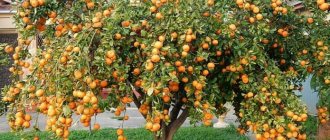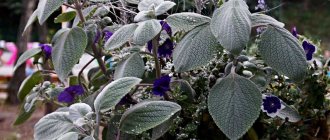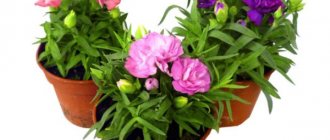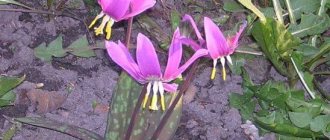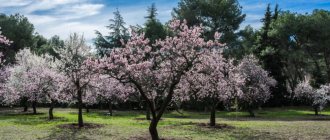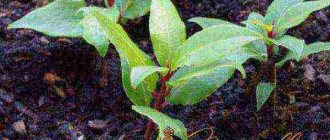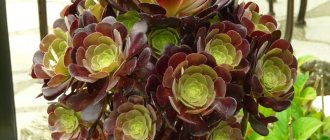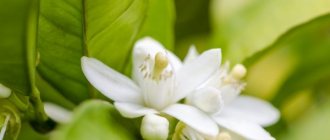Description of the plant
Olive, or European olive, is found in the form of trees and shrubs. There are more than sixty plant varieties in the world.
An olive tree can live for more than half a century, and in Jerusalem there are trees that are two thousand years old. The plant can be kept at home for about ten years, after which it needs to be transplanted to an open area. .
Young domestic olive trees are characterized by light-colored bark that darkens with age. The leaves of the trees last even in winter and are renewed every two years. The flowers are small and white. The fruits grow up to three centimeters long and weigh about five grams, and can be green or dark purple in color.
Olive fruits contain many substances beneficial to the human body. Eating fruits is useful for the prevention of diseases of the cardiovascular system, gastrointestinal tract and oncology.
Characteristic features of culture
The olive tree belongs to the olive family and is also known as the European olive.
Under natural conditions, olives grow in the hot Mediterranean. And, like many tropical crops, they also do well as a tub plant. Moreover, they will be even more comfortable indoors, especially in winter, because minus 5° below zero will already end in disaster for the tree. In nature, olive trees grow tall, but as an indoor crop their height does not exceed 2 m. And only if you decide to form a tree, olives can grow as a dense, spreading bush. But they tolerate haircuts well and are easy to shape. You can even make a bonsai from an olive tree, especially since the thick evergreen crown of many small narrow leaves looks gorgeous.
If the goal of growing is to get a harvest, buy two seedlings, a boy and a girl. Olives are bisexual and require cross-pollination.
How to get a potted olive
A homemade olive can be planted by rooting a cutting. You can also purchase a finished tree, but this will cost from 20 thousand rubles for a two-year-old olive. You can grow a plant from a seed, but such a tree will begin to bear fruit only after 12 years, while a tree grown from a cutting will take three years to do so.
Reproduction methods
There are several methods for propagating an olive tree, which allows gardeners to choose the best option.
Seeds
The pits should be taken from living olives. Canned fruits are not suitable because heat treatment deprives them of biological connections. The seeds should be soaked for 12-14 hours in a weak alkaline solution. Its concentration should be 10%. For the first planting you will need a pot with a diameter of 10 centimeters. The seeds must be washed and placed 2 centimeters deep in the soil. The first shoots will appear in 6-8 weeks. The ovaries on the plant are formed only after 10 years.
Cuttings
This is the most popular method of propagating the crop. Planting material should be harvested in the summer. To do this, you need to cut off 20 centimeters of sprouts from a plant that is 2-4 years old. The shoot should be 3-4 centimeters thick. To root the cutting, you need to leave it for several hours in a growth stimulator - Ecosil or Kornevin. Then the planting material should be immersed in water or wet sandy soil.
For the procedure to be successful, the plant needs to create favorable conditions:
- temperature – at least 20 degrees;
- good lighting without direct sunlight;
- high humidity.
Planting a tree in a pot
Fresh olive seeds sold in specialized stores are suitable for planting. Pickled olive pits are not suitable; nothing will sprout from them. Before planting, the seeds should be placed in an alkali solution for two-thirds of a day to get rid of the hard shell. After processing, the seeds should be dried.
See also
Beneficial and medicinal properties of walnuts for the body, contraindicationsRead
A suitable substrate for planting is one half consisting of river soil, and the other half equal parts turf and garden soil. Add a small amount of peat and lime.
Select an olive pot with a depth and width of 60 centimeters. There should be holes at the bottom of the container to drain excess moisture. Place some charcoal on the bottom of the pot.
Seeds should be planted in the soil to a depth of three centimeters. In order for the plant to take root, at first maintain the room temperature at 20 degrees and air humidity at a high level.
Features of growing olives indoors
Indoor olive does not require excessively careful care and is not susceptible to attack by pests, but in order for flowering and fruiting to take place, gardeners pay attention to the following points:
- Air moisture level and watering;
- Temperature conditions;
- Lighting;
- Substrate composition and transplantation.
Olive is known for its resistance to drought, so artificially increasing the level of moisture in the air is not necessary if the plant is not in a hot or heating season. If radiators or sun rays dry out the air, the leaves are sprayed daily with water from a spray bottle. Water the olive tree regularly with breaks to allow the soil to dry out. The remaining liquid from the pan is poured out; it will negatively affect the health of the root system. In winter, watering is reduced to once or twice a month.
Olive for home
Tips for caring for an olive tree at home
In order for the olive to grow healthy and bear fruit, you need to follow some rules. Growing olives requires a certain temperature, light regime and regular watering.
Location and lighting
To ensure the tree grows, maintain bright lighting. In the summer season, it is preferable to take the olive tree out into the garden or onto the balcony to give access to the sun's rays. In the shade, the tree's growth will slow down and it will not bloom. During the winter season, provide the olive tree with maximum sunlight indoors.
Temperature
Homemade olive can withstand heat, and in winter the plant needs to be provided with a temperature of +5 degrees. In cold temperatures, the tree's growth will slow down, and in severe frost it may even die. During the growing season, maintain the temperature at +20 degrees so as not to ruin the crop.
Watering
The home olive can cope with short dry periods, but the plant has difficulty withstanding long-term drought. Young trees need regular watering. Adult plants need to be watered less frequently, the soil should dry between waterings, and excess moisture should be removed from the pallets. During the cold season, the plant should be watered rarely.
Air humidity
In terms of air humidity, olives do not require special conditions. Natural humidity in summer - outdoors and in winter - indoors is sufficient for the plant. In hot weather, the tree should be sprayed with water at room temperature two to three times a day.
Feeding
In the spring, once every couple of weeks, feed the plant with organic preparations that combine nitrogen. In summer, olive trees require complex mineral fertilizers. In addition, spraying with succinic acid supplements fertilizing and helps plant development.
Trimming
Olive needs regular pruning for sanitary purposes. At the beginning of spring, areas damaged by insects are cut off for a tree growing in open conditions. Olives are pruned in the spring, also for decorative purposes. The crown in the form of a neat ball can be successfully formed using hand pruners. When pruning, remove weak branches and leave strong ones.
When carrying out the procedure, keep in mind that olive fruits grow only on last year's shoots, so trim them carefully so as not to destroy the crop.
See also
Description and yield of the Chandler nut variety, planting and careRead
Transfer
Replant the plant every few years. An olive tree at a young age tolerates soil changes well, but in an adult tree the roots may be damaged when transplanted. Provide a suitable location for transplantation. Rotten soil can cause the plant to wilt. When replanting, it is useful to add charcoal to the soil.
Pests, diseases and treatment of Olive Bonsai
Olive is practically disease-free and resistant to pests.
Pests and treatment
Possible damage by caterpillars, scale insects and false scale insects, leaf rollers, and olive leafminer moth . Signs include the appearance of uneven brown spots on the leaves. Leaves fall, tree growth slows down, and photosynthesis deteriorates. For treatment, remove and burn affected leaves. Treat with insecticides (methonyl, parathion and others).
The olive fly mainly affects ripening fruits. For treatment, remove and burn the affected fruits.
The psyllid , or honeyweed, lays eggs on the branches. In spring, the larvae suck out the juice from the buds, leaf blades, and shoot tips. This causes the leaves to curl. Young shoots are stunted in growth. Sooty fungi settle on the honeydew secreted by insects, covering the branches and leaves with a black coating. To treat, spray affected plants with phosphorus and organochlorine insecticides. In case of severe damage, treat with systemic insecticides.
Ladybugs and bedbugs are beneficial insects that exterminate pests.
Diseases and treatment
If leaf fall , this is not the norm. Pay attention to watering. It may be necessary to introduce spraying of the crown. Also try applying complex mineral fertilizer to restore the plant’s strength.
With excessive watering and poor drainage, Olive may become infected with fungi . In this case, stop watering, place the tree in a dry and sunny place, and treat with fungicides.
Olive trees are also susceptible to tuberculosis . A sign is the appearance of blisters on the surface of the branches and trunk. It is almost impossible to cure, but can be controlled by removing tuberculous tubercles or using copper-based phytosanitary substances.
Diseases and pests
Olive has good immunity against pests. However, in the absence of proper care, excess moisture, improper light and temperature conditions, the plant is susceptible to attack by harmful bacteria and fungi.
The greatest danger is tuberculosis. As a result of infection, the plant becomes covered with large blisters. In the vast majority of cases, an infected tree cannot be completely cured, but small foci of infection can be cut off and treated with copper sulfate to minimize the damage.
Due to excess moisture, the olive tree may become rotten or rusty. Biological fungicides, for example, Fundazol, help well against rot. To combat parasitic insects like olive moths, Actellik, Karbofos and other insecticides are widely used.
Black scale insects cause great harm to olive trees. Their appearance indicates that the plant is affected by harmful insects. Scale insects lay a huge number of eggs in the bark. Scale insects affect both diseased and completely healthy trees.
To prevent infections, it is enough to properly care for the olive tree. Fortunately, olive is an unpretentious tree, so it will be enough to provide it with the minimum required amount of moisture, as well as the correct temperature and light conditions. The tree should be protected from pests using natural biological preparations, since chemicals negatively affect the yield, killing the beneficial properties of the fruit.
Blooming olive: care
During the flowering period, the plant needs more careful care. At this time, it is very important to monitor the condition of the soil. Watering is carried out as needed (when the top layer of soil dries out). If there is not enough moisture, the plant's leaves become dull, curl, and then fall off. This may even lead to the death of the tree.
Slightly yellowish or completely white flowers with a delicate and refined aroma bloom in mid-June. At home, the tree is decorated with delicate flowers for several months. The plant is pollinated by wind and insects, but daily shaking of the branches is necessary for home olives. With self-pollination, fruits can be set in different sizes, and cross-pollination significantly improves their quality and yield.
Despite the fact that the olive tree tolerates dry air well, we recommend spraying its crown in extreme heat. Until the age of four, the plant needs annual replanting. This is usually done in early spring, and it is not necessary to change the entire contents of the pot; it is enough to replace only the top layer of soil with a more fertile and fresh one.
Olive propagation methods
An olive tree can be grown at home using seeds or cuttings. Each of these methods has its own advantages and disadvantages .
Seeds
Growing olives from seeds is a rather time-consuming and labor-intensive method. It can take as much as 15 years for the first fruits to appear after planting. For planting, fresh seeds with a shell dissolved in alkali are used. Germination occurs after three months. For the first five years, the seedling needs to be replanted annually, after which replanting is carried out every couple of years.
Cuttings
Vegetative propagation is the fastest way to grow a plant. With this method, the seedling inherits the characteristics of the variety and blooms much faster.
First you need to prepare annual cuttings, treating the cut sites for rooting. The cuttings should be planted in wet sand in a transparent container. It is necessary to maintain a temperature regime of about 20 degrees Celsius. It is necessary to moisten the plant in a timely manner. The cuttings should be transplanted to a permanent place in late summer, early autumn.
Olive tree at home. Growing with seeds, seedlings and cuttings
Growing an olive tree indoors is quite a painstaking job. It's all about the temperature regime, if it is not observed, the tree will not bear fruit. In order for buds to appear, the indoor tree, like its soil counterparts, must fall into winter sleep, so the olive must be exposed to low temperatures, but avoid overcooling the crop. The optimal temperature for sleeping will be from +1 to +5 degrees.
The flowering of the olive tree is accompanied by the appearance of large white inflorescences; the first flowers appear in April and May. Ripening of indoor fruits after flowering occurs after four months.
A good yield for an olive tree is considered to be about 30 kg, but a houseplant is considered fruitful if it produces about 600 grams. olives
The indoor olive tree remains evergreen throughout its entire life, however, like its large relatives, it can shed its leaves; this is considered the norm and does not require resuscitative actions.
Growing an olive tree from seeds is not an easy process and requires patience and attention. First, you need to purchase olive seeds (pits), canned products are not suitable, olives for planting can be fresh or dried.
So, having obtained and cleaned the olives, you need to soak the resulting pits in a weak alkali solution for a day, then rinse them with water and dry them with a paper towel. Before planting, you should cut down the olive seed shell to facilitate germination. It is better to plant in a pot, as it is easier to control seed germination, humidity and temperature.
The sawn seeds are placed in a pot with soil to a depth of 3 cm; do not allow the seed to dry out or over-moisten it. The first shoots will appear within six months.
Olive trees do not tolerate low temperatures, so propagation by seeds is carried out in a warm room or in the summer.
To speed up the process of growing an olive tree from a seed, you should germinate the seeds before planting in the ground, to do this, place them in a shallow container with compost, place them on a sunny windowsill and moisten them daily.
When the seeds germinate, you can begin planting in the soil. It is necessary to mix chernozem and sand in equal parts, add peat, dry crushed lime and plant seeds in the resulting mixture. Before planting, do not forget about the presence of drainage (olive does not tolerate stagnant water) and hardening of the young plant using the method of alternating temperatures.
When the olive seedling gets stronger and grows, it can be planted in the ground, along with the contents of the pot, so as not to damage the root system. The olive tree is planted in the spring in well-warmed and moist soil, in an area that is windless and rich in sunlight. Fruiting should be expected three to four years after planting.
Caring for a young oilseed plant consists of cutting off the lower shoots so that the tree grows upward and does not turn into a bush, daily watering and fertilizing with fertilizers.
When an olive tree is propagated by cuttings, the tree inherits all the “maternal” qualities; this planting method simplifies further cultivation and speeds up the process of fruiting of the young plant.
Cuttings should be carried out from older shoots; the cut sites are treated with succinic acid or another rooting agent before planting. Planting material is planted in a moist turf-sand mixture to a depth of 15 cm.
Constant watering, warm soil and good lighting can help the cuttings take root. Plants should be watered daily, preferably with settled water. Rooting of the plant will occur no earlier than four months later. If the olive cutting does not take root for a long time, but retains its fresh appearance, then some more time is needed, but if the cutting has dried out and turned brown, then death has occurred. Once the cuttings have taken root, the olive can be transplanted into the ground.
Planting to a permanent growth site should be done at the end of August. The seedling is carefully removed from the pre-moistened substrate and placed in a new prepared place. The cuttings must be planted carefully, without damaging the roots or overloading them with soil, until the plant takes root in its new location.
Many novice gardeners ask the question: “How to care for an olive tree”? The olive tree is not capricious, but the “southerner” still requires attention. Watering is done daily, but without stagnating moisture in the soil. When the olive tree begins to actively grow, feed it with mineral fertilizers and nitrogen. The seedling must have enough warmth and light, otherwise the olive tree will begin to shed its leaves and become dull.
In winter, an olive plant cannot be left in the open ground without proper protection. A young tree should be protected from the cold by wrapping the trunk with thermal insulation material, and stop watering and fertilizing.
Potted olive tree crops need to artificially create winter conditions, and in the process of healing the tree, by cutting dry branches, you can shape the foliage crown to your liking and learn the art of bonsai on your olive tree. Olive bonsai trees can also be purchased at a specialized supermarket; small-leaved varieties look especially impressive.
Olive (Olive) European, or olive tree
Olea europaea L.
- Olive - Oleaceae
- Pharmacy name: olive oil - Olivae oleum (formerly: Oleum Olivarum).
Botanical description
The original form of this evergreen plant is shrubby, cultivated, tree-like, 6-8 m in height. The leaves are leathery, pubescent on the underside. The flowers are small, yellowish-white, fragrant. Fatty oil is obtained from dark blue fruits (olives). Its homeland is the eastern Mediterranean, but the olive is cultivated in many countries on all continents.
Active ingredients
The oil is composed of butyric acid glycerides and other fatty acids. The leaves contain secoiridoids and flavonoids.
The olive tree has been highly revered at all times. It is known that Moses ordered the exemption of men who grew olives from military service. Olive oil was considered a symbol of purity and virtue, and the olive branch symbolized peace and prosperity. The winners of the Olympic Games in Greece were crowned with a wreath of olive leaves. In traditional medicine, the leaves were used to treat fevers and infections, and topically to treat wounds. Herbalists make poultices out of them to help with skin rashes.
Olive leaves contain a large number of beneficial components, including oleuropein and several different flavonoids (for example, rutin, apigenin, luteolin, crisoeriol, hesperidin, quercet, and kaemferol). The most active compound in olive leaves is considered to be oleuropein, a bitter glycoside from the class of secoiridoids. It is also one of the main components of the polyphenolic fraction of olive oil. Oleuropein and its hydrolysis products, such as elenoic acid, aglycone and calcium elenolate, a salt of elenoic acid, have their own unique multifaceted properties. Elenoic acid has been shown by American researchers to have activity against microorganisms such as Bacillus subtiluis, Lactobacilli and Staphylococcus aureus.
In animal experiments, oleuropein, when administered intramuscularly or intravenously, reduced blood pressure (systolic and diastolic) and dilated the arteries surrounding the heart. This hypotensive effect explains why olive oil is traditionally used to treat mild to moderate hypertension. Like other biophenols from extra virgin olive oil, oleuropein has some important antioxidant properties. In a preclinical trial, oleuropein was shown to reduce the oxidation of “bad” cholesterol associated with low-density lipoprotein cholesterol (LDL-cholesterol). LDL oxidation is one of the process steps that can lead to the development of atherosclerosis. The protective effect of oleuropein may explain why the Mediterranean diet (using olive oil) can reduce the risk of developing this disease.
Olive leaf extract reduced elevated blood glucose levels in diabetic animals in a study on rabbits. This hypoglycemic activity is due to two mechanisms: potentiation of glucose-stimulated insulin release and increased peripheral glucose uptake. Extracts of leaves collected in the winter months have higher hypoglycemic activity.
Olive leaf extract promotes detoxification at the cellular level, especially during times of stress. It has been shown to protect RNA structure from damage. Renowned physician Dr. James Privitera from California has the most experience using olive leaf extract in his clinical practice since 1995. According to his observations, it has the following beneficial effects: reduces joint inflammation in arthritis; allows patients with diabetes to reduce insulin doses; relieves symptoms of chronic fatigue syndrome; increases energy and endurance; improves blood circulation in cardiovascular diseases; reduces pain from hemorrhoids; relieves toothache; destroys fungal infections (onychomycosis, mycosis of the feet); prevents and treats many viral infections; relieves symptoms of Candida albicans and other fungal infections, destroys and removes many parasites, including protozoa and helminths.
Healing effect and application
Olive oil is used in the manufacture of ointments, emulsions, liniments and lotions. Olive leaf tea is prescribed for high blood pressure.
